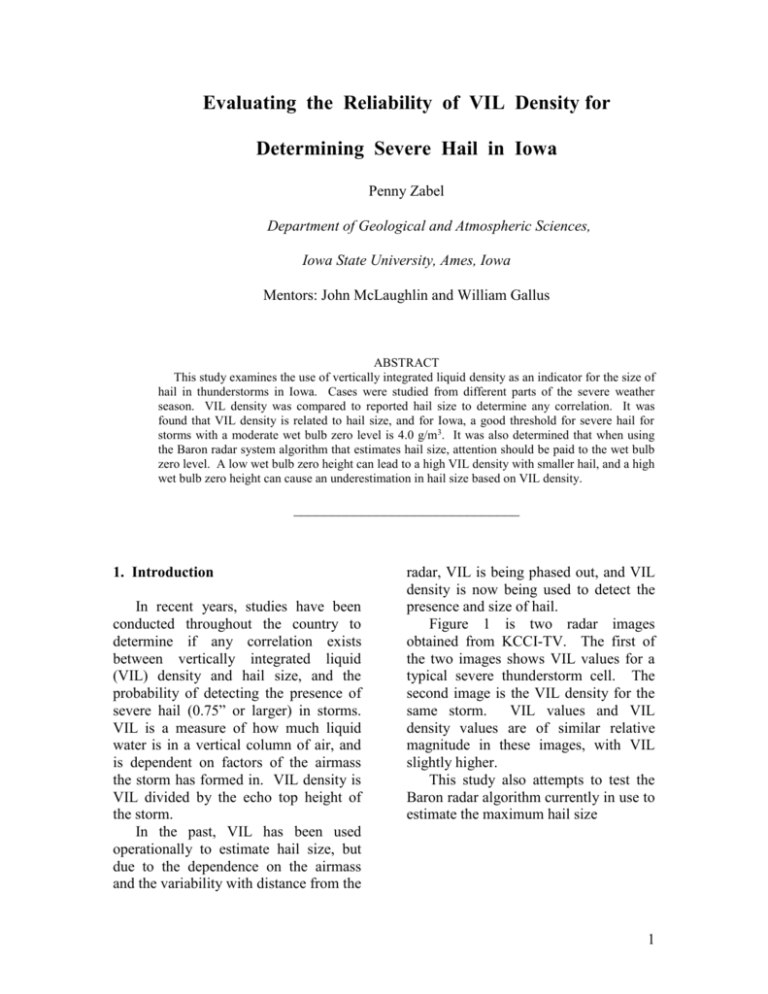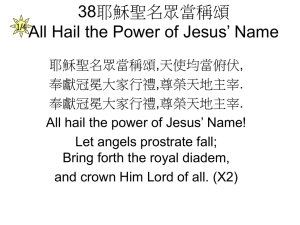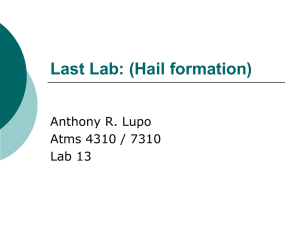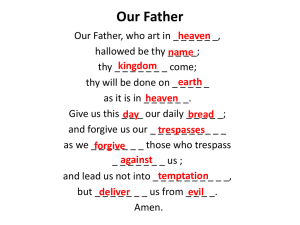Evaluation of the Reliability of VIL Density for
advertisement

Evaluating the Reliability of VIL Density for Determining Severe Hail in Iowa Penny Zabel Department of Geological and Atmospheric Sciences, Iowa State University, Ames, Iowa Mentors: John McLaughlin and William Gallus ABSTRACT This study examines the use of vertically integrated liquid density as an indicator for the size of hail in thunderstorms in Iowa. Cases were studied from different parts of the severe weather season. VIL density was compared to reported hail size to determine any correlation. It was found that VIL density is related to hail size, and for Iowa, a good threshold for severe hail for storms with a moderate wet bulb zero level is 4.0 g/m3. It was also determined that when using the Baron radar system algorithm that estimates hail size, attention should be paid to the wet bulb zero level. A low wet bulb zero height can lead to a high VIL density with smaller hail, and a high wet bulb zero height can cause an underestimation in hail size based on VIL density. ______________________________ 1. Introduction In recent years, studies have been conducted throughout the country to determine if any correlation exists between vertically integrated liquid (VIL) density and hail size, and the probability of detecting the presence of severe hail (0.75” or larger) in storms. VIL is a measure of how much liquid water is in a vertical column of air, and is dependent on factors of the airmass the storm has formed in. VIL density is VIL divided by the echo top height of the storm. In the past, VIL has been used operationally to estimate hail size, but due to the dependence on the airmass and the variability with distance from the radar, VIL is being phased out, and VIL density is now being used to detect the presence and size of hail. Figure 1 is two radar images obtained from KCCI-TV. The first of the two images shows VIL values for a typical severe thunderstorm cell. The second image is the VIL density for the same storm. VIL values and VIL density values are of similar relative magnitude in these images, with VIL slightly higher. This study also attempts to test the Baron radar algorithm currently in use to estimate the maximum hail size 1 82 g/m^2 (a) 4.25 g/m^3 (b) FIG. 1. (a) VIL values of a cell on July 2, 1999, approximately 70 miles from the radar. (b) VIL Density values as calculated by the Baron radar for same time and position as figure1. Both figures 1 and 2 are typical of Iowa storms containing hail. possible within storms based on the VIL Density. This study examines 6 hail events across western and central Iowa and analyzes differences due to time of year and distance from the radar, as well as atmospheric conditions. The radar data used came from the Baron radar display system from KCCI-TV in Des Moines which utilizes the WSR-88D data. Null cases were not included in this study. 2. Previous Studies In one of the first VIL density studies, Amburn and Wolf (1996) studied 221 storms in the Tulsa, Oklahoma area, and found that a VIL Density of 3.5 g/m3 verified 90% of severe hail cases. This is similar to a paper done by Baumgardt and King (2002) in LaCrosse, Wisconsin. They also found 3.5 g/m3 to verify 90% of their 70 cases (Baumgardt and King, 2002). Troutman and Rose (1997) found a VIL density of 3.5 g/m3 to verify only 81% of cases in the Nashville warning area. The Baron Radar algorithm developed by Dr. Greg Wilson is based on the results of a study published by Roeseler and Wood (1997). This study was based along the northwest coast of the Gulf of Mexico. They found 3.5 g/m3 VIL density to only verify 72% of all severe hail reports (Roeseler and Wood, 1997). Hart and Frantz (1998) did a study on the effects of wet bulb zero height on the size of hail. They found a VIL density of 3.5 g/m3 to verify 79% of severe hail cases. Hart and Frantz went further and analyzed the atmospheric conditions surrounding these cases. They found 67% of the large hail cases to have wet bulb zero heights between 7000 and 11000 ft. This is one of few studies so far relating VIL and wet bulb zero height (Hart and Frantz, 1998). 3. VIL and VIL Density VIL is a function of reflectivity and converts weather radar reflectivity data into an equivalent liquid-water content value (Amburn and Wolf, 1996). VIL is defined as: VIL = ∑3.44*10-6 [(Zi + Zi+1)/2]4/7dh where Zi and Zi+1 are the radar reflectivity at the bottom and top of the layer dh. 2 Reflectivity is measured by the back scattering of energy back to the radar after being directed into the storm. It is assumed that all the reflectivity measured by the beam is from liquid water. Reflectivity is highly dependent on the size of the target object in the radar equation. It is proportional to the diameter of the object to the 6th power. This will cause an overestimation of reflectivity and liquid water content when hail is present because hail is much larger than the largest raindrops. This will in turn result in an increased VIL value. 23 g/m^2 (a) VIL Density is defined as: VIL Density = VIL / Echo Top * 1000 Multiplication by 1000 is needed to get units of g/m3 rather than kg/m3. VIL Density is used to account for the difference in vertical height of storms. By dividing by the echo top, VIL is normalized and helps to eliminate problems due to the cone of silence and if the storm is far from the radar. Cone of silence errors result when the storm is close to the radar. The radar can not scan directly above itself, and thus leaves a gap in data for a circle approximately 25 miles in diameter. Figure 2 shows images of VIL and VIL density for a storm that is approximately 10 miles away from the radar. Typically, VIL and VIL density values will be of similar magnitude. These images show a much larger VIL density then VIL, due to the entire column not being sampled. VIL density eliminates this error. 5.25 g/m^3 (b) FIG. 2. (a)VIL values for a storm close to the radar site (b) VIL density values for the same time and position. Figure 3 is a plot of hail size vs. VIL for all reports in this study. There is no significant evidence from this graph that VIL and hail size are strongly correlated. Most cases had larger hail with higher VIL, but there are many outliers. This could be due partly to range from the radar. Figure 4 shows hail size vs. VIL density. Here, the correlation is much more obvious. There is a definite trend toward higher VIL densities with increasing hail size with only a few stray points. 3 Hail Size (in) VIL vs. Hail size 5 4 3 2 1 0 0 50 100 VIL (g/m^2) FIG. 3. VIL and associated hail size of all hail reports in this study. Hail Size (in) VIL Density Vs. Hail size 5 4 3 2 1 0 0 1 2 3 4 5 6 7 VIL Density (g/m^3) hail size of all hail reports in this study. FIG. 4. VIL density and associated 4. Methodology Radar information was obtained from WSR-88D radar data archived by KCCI-TV for 6 hail cases from 1998 through 2002. The cases were chosen to have two cases from spring, early summer, and late summer, all parts of the Iowa severe weather season. The number of cases was limited due to the availability of saved radar data and the lack of severe hail events in the 2002 season. Hail reports were obtained from the National Climactic Data Center website and the Storm Prediction Center website. VIL, echo top, and VIL density from the WSR-88D were recorded, and hail size as estimated by the Baron algorithm was also recorded for each report of hail within the range of the radar, as well as the distance of each report from the radar. The beam height was then estimated using a VCP 11 chart. Measurements were recorded for the best estimate of when the hail likely 4 occurred within a 10 minute window of the report time. The reports are from the public, and trained storm spotters. There is no guarantee of the accuracy of all these reports, and the report may not represent the largest hail that occurred. Hail smaller than ¾ in. was not considered in this study due to lack of reports. The following are the dates and atmospheric conditions for the studied storms. Date April 8, 1999 April 18, 2002 May 30, 1998 July 7, 2001 Sept. 7, 2001 Sept. 18, 2002 Wet Bulb Freezing Zero height Level (ft) (ft) 6,895 10,032 8,520 10,925 11,067 13,556 13,392 13,392 10,863 10,863 11,016 12,872 TABLE 1. Wet bulb zero height and freezing level for days in which hail was studied based on soundings from Omaha, NE. All atmospheric information was obtained from a radiosonde database access site (RAOB, 2002) using the Omaha soundings for the time nearest the event. The raw sounding data was processed using RAOB (Shewchuk, 1998). 5. Results The results of this research are similar to those found by previous studies. There definitely seems to be a relationship between VIL and echo top, and VIL density for estimating hail size. Other studies have found 3.5 g/m3 to be a good threshold for severe hail. This study has shown that for storms in Iowa, a VIL density of 4.0 g/m3 is a better indicator of possibly severe hail. Only 8 severe hail reports out of the 111 studied had a VIL density of less than 4.0 g/m3. This works out to 93% of the cases being verified by 4.0 g/m3 VIL density or greater. There were no severe hail reports in the studied cases with a VIL density of less than 2.75 g/m3. Table 2 shows the average VIL density for hail sizes. As is expected, the average VIL density increases with hail size. Hail size 0.75”-0.99” 1.00”-1.99” 2.00” and greater VIL density 4.39 g/m3 4.6 g/m3 5.30 g/m3 TABLE 2. Average VIL density per hail sizes. It was also found that there is a preferred wet bulb zero level for the accuracy of VIL density. On April 8, 1999, the wet bulb zero height was less than 7000 ft. On this day, there was a case of a VIL density of 5.25 g/m3 with only 1” hail. The opposite was also true. On July 2, 1999, the wet bulb zero height was greater than 13,000 ft. This resulted in one report of 1.75” hail, where the VIL density was only 3.5 g/m3. The effects of wet bulb zero were not studied extensively in this research, but some theories were maintained: When the wet bulb zero height is very low, more of the targets reflecting the radar beam may be frozen rather than liquid drops. This will cause a high VIL density calculation. One reason for small hail when the VIL is high is that a low wet bulb zero height can signifies a relatively stable atmosphere or low top convection, where hail does not have enough below freezing area to get large. The stable atmosphere would lead to small updrafts, and hinder the growth of hail. The opposite can also be assumed. 5 The algorithm and thresholds used by the Baron Radar system are based on studies done in the southeast United States. This area has high freezing levels, and wet bulb zero levels. The algorithm consistently overestimated hail size for every day of storms that was studied. Figure 5a is the same scatter plot as figure 4, but with the estimated hail size added. Figure 5b shows the estimated hail size versus actual hail size for all the cases. It can be seen here that hail size is being overestimated. If the radar is being used in a cooler climate, like Iowa, where the wet bulb zero level is not going to be as high as in the southeast United Stated, adjustments 6. Conclusions It has been shown that VIL density can be a good indicator for the size of hail in Iowa and other parts of the country. In Iowa, 4.00 g/m3 appears to be a good threshold for severe hail. Other VIL density suggestions are noted in Table 3. Hail size 0.75” – 0.99” 1” – 1.99” 2” – 2.99” 3” and greater VIL density 4.00 g/m3 4.25 g/m3 4.50 g/m3 5.00 g/m3 Hail Size (in) TABLE 3. Hail size and suggested VIL density thresholds based on results of this study. 5 4 3 2 1 0 0 1 2 3 4 5 6 7 VIL Density (g/m^3) Estimated Hail Size (a) 6 5 4 3 2 1 0 0 1 2 3 4 5 6 Hail Size (b) FIG. 5. (a) Blue points are hail size and associated VIL density for all cases. Estimated hail size for VIL density are in purple. (b) Blue points represent hail size plotted against the estimated hail size. The red line represents the perfect reliability line, while the green line is the estimated size decr eased by ¼ inch. 6 may need to be made to the estimated hail size computed by the system. In the case of Iowa, the results of this study indicate that the estimated hail size needs to be reduced by ¼ inch (Fig. 5b). Whether using the Baron system or not, a meteorologist also needs to be aware of atmospheric conditions. Low wet bulb zero heights can lead to overestimations of hail size based on VIL, and high wet bulb zero heights can lead to underestimations. Other factors that need to be kept in mind are the speed and tilt of the storm. If the storm is moving fast, the top of the storm may already have moved out of the grid column before the whole storm is sampled. This means some of the reflectivity from the vertical storm column would be measured into the grid space next to it. The same can happen if the storm is strongly tilted. The radar is sampling in a vertical column and part of the storm may be in the next grid box. It is important to remember that VIL density is only one radar indicator of severe hail. Operational meteorologists must also be sure to look for other signatures of hail on radar. The three-body scatter spike is one possible tell-tale sign of hail. This is caused when the hailstones are larger than about 1 in. in diameter. Mei scattering starts to effect the radar beam, and the hail stone reflects a portion of the radar energy down to the ground. The ground then backscatters it to the hail stone, and back to the radar. This causes a delay in the amount of time it takes for the energy to return to the receiver, and the radar will assume this is caused by rain at a greater distance than what it really is. Figure 6 is a good example of a three-body scatter spike. The radar is located to the east of this storm. There is a long spike out the left side of the highest reflectivity area. (a) (b) FIG. 6. (a) A Three body scatter spike on radar. The blue box shows the VIL, VIL density, and max estimated hail size for this storm. (b) An enlargement of the box in the corner of figure 6a. Another easy signature to pick out is the bounded weak echo region, or BWER. This results from very strong updrafts on the edge of a storm. It typically looks like a small hole or donut in the upper levels of the radar scans. Looking at the lowest level radar (figure 7a), and a level in the middle of the storm (figure 7b), there will be an area of weaker reflectivity above where some stronger reflectivity was. Higher up in the storm (figure7c) there will be the area of low reflectivity where the strong updraft is likely creating large hail. Surrounding this will be stronger returns 7 BREF 1 BREF 2 (a) (b) BREF 3 (c) FIG. 6. Three levels of a storm showing a BWER where rain and hail are escaping the updraft. Acknowledgements. The author thanks John McLaughlin for all his help with this research, as well as Dr. William Gallus, Greg Wilson, and the numerous people who helped with editing. REFERENCES Amburn, S., and P. Wolf, 1996: VIL density as a hail indicator. 18th Conf. on Severe Local Storms. San Francisco, CA, Amer. Meteor. Soc., 581-585. American Meteorological Society, 1993: Nexrad Information Dissemination Services (NIDS). Unysis Corporation, 455. ______, 2000: Glossary of Meteorology. American Meteorological Society, 855. Baumgardt, D. A., and C. King, 2002: Verification of the WSR-88D build 9.0 hail algorithm over the upper Midwest. [Available online at http:// www.crh.noaa.gov/arx/hailstudy.html.] Edwards, R., and R. Thompson, 1998: Nationwide comparisons of hail size with WSR-88D vertically integrated liquid water (VIL) and derived thermodynamic sounding data. Wea. Forecasting. 13, 277-285. Hart, P.A., and K. Frantz, 1998: A comparison of VIL density and wet bulb zero height associated with large hail over north and central Georgia. SR/SSD 98-30. National Climactic Data Center, cited 2002: Extreme weather and climate events. [Available online at http:// lwf.ncdc.noaa.gov/oa/climate/severeweather /extremes.html.] 8 RAOB, cited 2002: Radiosonde database access. [Available online at http://raob.fsl.noaa.gov/] Roeseler, C.A., and L. Wood, 1997: VIL density and associated hail size along the northwest Gulf coast. Preprints, 28th Conf. On Radar Meteorology, Austin, TX, Amer. Meteor. Soc, 434-435. Shewchuk, J., 1998: RAOB Version 4.0. Environmental Research Services. Storm Prediction Center, cited 2002: Storm reports. [Available online at http://www.spc.noaa.gov/climo/.] Troutman, T., and M. Rose, 1997: An examination of VIL and echo top associated with large hail in middle Tennessee. SR/SSD 97-15. 9









